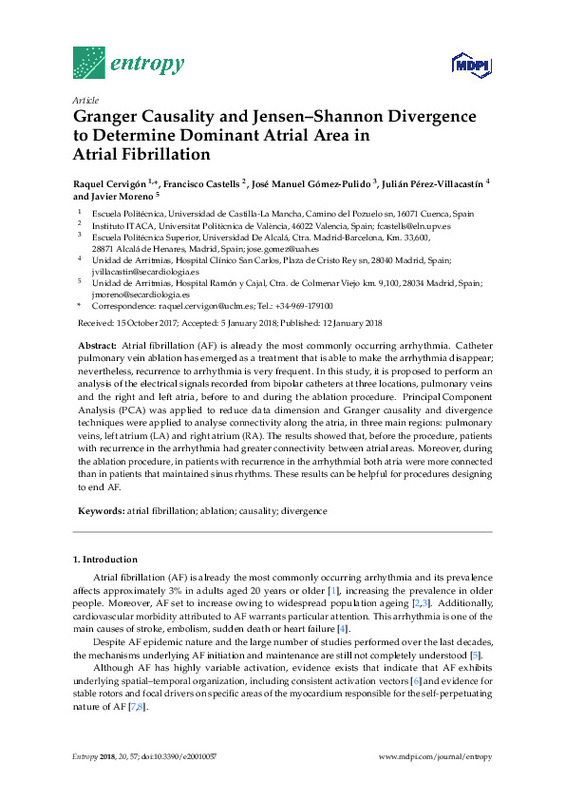JavaScript is disabled for your browser. Some features of this site may not work without it.
Buscar en RiuNet
Listar
Mi cuenta
Estadísticas
Ayuda RiuNet
Admin. UPV
Granger Causality and Jensen-Shannon Divergence to Determine Dominant Atrial Area in Atrial Fibrillation
Mostrar el registro sencillo del ítem
Ficheros en el ítem
| dc.contributor.author | Cervigón, Raquel
|
es_ES |
| dc.contributor.author | Castells, Francisco
|
es_ES |
| dc.contributor.author | Gómez-Pulido, José Manuel
|
es_ES |
| dc.contributor.author | Pérez-Villacastín, Julián
|
es_ES |
| dc.contributor.author | Moreno, J.
|
es_ES |
| dc.date.accessioned | 2019-05-31T20:42:51Z | |
| dc.date.available | 2019-05-31T20:42:51Z | |
| dc.date.issued | 2018 | es_ES |
| dc.identifier.issn | 1099-4300 | es_ES |
| dc.identifier.uri | http://hdl.handle.net/10251/121354 | |
| dc.description.abstract | [EN] Atrial fibrillation (AF) is already the most commonly occurring arrhythmia. Catheter pulmonary vein ablation has emerged as a treatment that is able to make the arrhythmia disappear; nevertheless, recurrence to arrhythmia is very frequent. In this study, it is proposed to perform an analysis of the electrical signals recorded from bipolar catheters at three locations, pulmonary veins and the right and left atria, before to and during the ablation procedure. Principal Component Analysis (PCA) was applied to reduce data dimension and Granger causality and divergence techniques were applied to analyse connectivity along the atria, in three main regions: pulmonary veins, left atrium (LA) and right atrium (RA). The results showed that, before the procedure, patients with recurrence in the arrhythmia had greater connectivity between atrial areas. Moreover, during the ablation procedure, in patients with recurrence in the arrhythmial both atria were more connected than in patients that maintained sinus rhythms. These results can be helpful for procedures designing to end AF. | es_ES |
| dc.description.sponsorship | This work has been supported by the Spanish Government, under the grant DPI2015-70821-R received from the research program Retos de la Sociedad' by the Ministry of Economics and Competitiveness. | es_ES |
| dc.language | Inglés | es_ES |
| dc.publisher | MDPI AG | es_ES |
| dc.relation.ispartof | Entropy | es_ES |
| dc.rights | Reconocimiento (by) | es_ES |
| dc.subject | Atrial fibrillation | es_ES |
| dc.subject | Ablation | es_ES |
| dc.subject | Causality | es_ES |
| dc.subject | Divergence | es_ES |
| dc.subject.classification | TECNOLOGIA ELECTRONICA | es_ES |
| dc.title | Granger Causality and Jensen-Shannon Divergence to Determine Dominant Atrial Area in Atrial Fibrillation | es_ES |
| dc.type | Artículo | es_ES |
| dc.identifier.doi | 10.3390/e20010057 | es_ES |
| dc.relation.projectID | info:eu-repo/grantAgreement/MINECO//DPI2015-70821-R/ES/CARACTERIZACION DE LA MIOCARDIOPATIA ARRITMOGENICA A PARTIR DE TECNICAS AVANZADAS DE SEÑALES E IMAGENES PARA LA DEFINICION DE NUEVOS MARCADORES DIAGNOSTICOS/ | es_ES |
| dc.rights.accessRights | Abierto | es_ES |
| dc.contributor.affiliation | Universitat Politècnica de València. Departamento de Ingeniería Electrónica - Departament d'Enginyeria Electrònica | es_ES |
| dc.description.bibliographicCitation | Cervigón, R.; Castells, F.; Gómez-Pulido, JM.; Pérez-Villacastín, J.; Moreno, J. (2018). Granger Causality and Jensen-Shannon Divergence to Determine Dominant Atrial Area in Atrial Fibrillation. Entropy. 20(1):1-14. https://doi.org/10.3390/e20010057 | es_ES |
| dc.description.accrualMethod | S | es_ES |
| dc.relation.publisherversion | http://doi.org/10.3390/e20010057 | es_ES |
| dc.description.upvformatpinicio | 1 | es_ES |
| dc.description.upvformatpfin | 14 | es_ES |
| dc.type.version | info:eu-repo/semantics/publishedVersion | es_ES |
| dc.description.volume | 20 | es_ES |
| dc.description.issue | 1 | es_ES |
| dc.relation.pasarela | S\360421 | es_ES |
| dc.contributor.funder | Ministerio de Economía y Empresa | es_ES |








